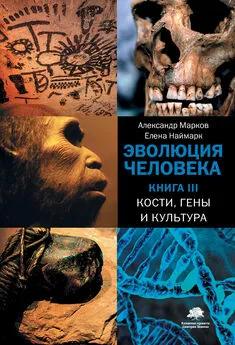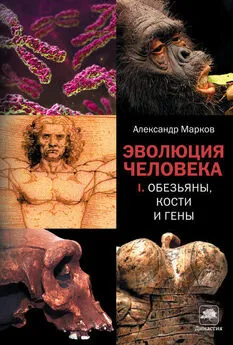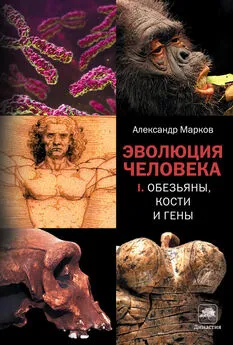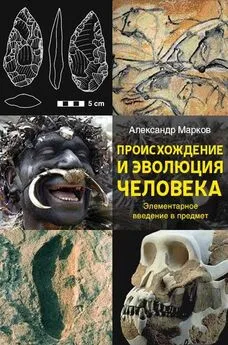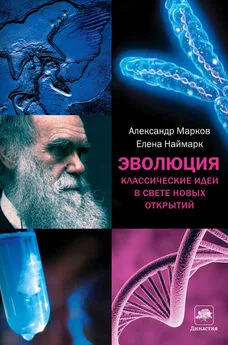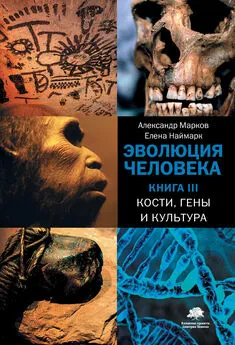Александр Марков - Эволюция человека. Книга 3. Кости, гены и культура
- Название:Эволюция человека. Книга 3. Кости, гены и культура
- Автор:
- Жанр:
- Издательство:АСТ : CORPUS
- Год:2022
- Город:Москва
- ISBN:978-5-17-137580-5
- Рейтинг:
- Избранное:Добавить в избранное
-
Отзывы:
-
Ваша оценка:
Александр Марков - Эволюция человека. Книга 3. Кости, гены и культура краткое содержание
Эволюция человека. Книга 3. Кости, гены и культура - читать онлайн бесплатно ознакомительный отрывок
Интервал:
Закладка:
HorvÁth K. et al. 2011. Is the social brain theory applicable to human individual differences? Relationship between sociability personality dimension and brain size // Evolutionary Psychology. V. 9. P. 244–256.
Hsieh P. et al. 2016. Model-based analyses of whole-genome data reveal a complex evolutionary history involving archaic introgression in Central African Pygmies // Genome Research. V. 26. P. 291–300.
Hublin J.-J. et al. 2015. Brain ontogeny and life history in Pleistocene hominins // Philosophical Transactions of the Royal Society B. V. 370. 20140062.
Hublin J.-J. et al. 2017. New fossils from Jebel Irhoud, Morocco and the pan-African origin of Homo sapiens // Nature. V. 546. P. 289–292.
Humphrey N. K. 1976. The social function of intellect / Bateson P. P. G., Hinde R. A., eds. Growing points in ethology . Cambridge: Cambridge University Press. P. 303–317.
Ingicco T. et al. 2018. Earliest known hominin activity in the Philippines by 709 thousand years ago // Nature. V. 557. P. 233–237.
Jacobs G. S. et al. 2019. Multiple deeply divergent Denisovan ancestries in Papuans // Cell. V. 177. P. 1–12.
Jacobs Z. et al. 2019. Timing of archaic hominin occupation of Denisova Cave in southern Siberia // Nature. V. 565. P. 594–599.
Jesmer B. R. et al. 2018. Is ungulate migration culturally transmitted? Evidence of social learning from translocated animals // Science. V. 361. P. 1023–1025.
Johnstone B. et al. 2012. Right parietal lobe-related “selflessness” as the neuropsychological basis of spiritual transcendence // The International Journal for the Psychology of Religion. V. 22. P. 267–284.
Joordens J. C. A. et al. 2009. Relevance of aquatic environments for hominins: a case study from Trinil (Java, Indonesia) // Journal of Human Evolution. V. 57. P. 656–671.
Joordens J. C. A. et al. 2014. Homo erectus at Trinil on Java used shells for tool production and engraving // Nature. V. 518. P. 228–231.
Kaplan H. S., Robson A. J. 2002. The emergence of humans: the coevolution of intelligence and longevity with intergenerational transfers // PNAS. V. 99. P. 10221–10226.
Kipling R. 1902. The cat that walked by himself / Kipling R. Just so stories . London: Macmillan and Co. [Киплинг Р. 1929. Кошка, гулявшая сама по себе. М.-Л.: Государственное издательство.]
KorleviĆ P. et al. 2015. Reducing microbial and human contamination in DNA extractions from ancient bones and teeth // Biotechniques. V. 59. P. 87–93.
Krebs J. R. 1990. Food-storing birds: adaptive specialization in brain and behaviour? // Philosophical Transactions of the Royal Society B. V. 329. P. 153–160.
KÜhl H. S. et al. 2016. Chimpanzee accumulative stone throwing // Scientific Reports. V. 6. 22219.
KÜhl H. S. et al. 2019. Human impact erodes chimpanzee behavioral diversity // Science. V. 363. P. 1453–1455.
Kuhlwilm M. et al. 2016. Ancient gene flow from early modern humans into Eastern Neanderthals // Nature. V. 530. P. 429–433.
Lachance J. et al. 2012. Evolutionary history and adaptation from high-coverage whole-genome sequences of diverse African hunter-gatherers // Cell. V. 150. P. 457–469.
Laland K. N. 2017. Darwin’s unfinished symphony. How culture made the human mind . Princeton & Oxford: Princeton University Press.
Laland K. N., O’Brien M. J. 2011. Cultural niche construction: an introduction // Biological Theory. V. 6. P. 191–202.
Laland K. N. et al. 2001. Cultural niche construction and human evolution // Journal of Evolutionary Biology. V. 14. P. 22–33.
Laland K. N., Rendell L. 2013. Cultural memory // Current Biology. V. 23. P. R736–R740.
Leca J.-B. et al. 2010. Indirect social influence in the maintenance of the stone-handling tradition in Japanese macaques, Macaca fuscata // Animal Behaviour. V. 79. P. 117–126.
Leigh R. S. 2012. Brain size growth and life history in human evolution // Evolutionary Biology. V. 39. P. 587–599.
Lewis H. M., Laland K. N. 2012. Transmission fidelity is the key to the build-up of cumulative culture // Philosophical Transactions of the Royal Society B. V. 367. P. 2171–2180.
Li H., Durbin R. 2011. Inference of human population history from individual whole-genome sequences // Nature. V. 475. P. 493–496.
Li Z.-Y. et al. 2017. Late Pleistocene archaic human crania from Xuchang, China // Science. V. 355. P. 969–972.
Lordkipanidze D. et al. 2013. A complete skull from Dmanisi, Georgia, and the evolutionary biology of early Homo // Science. V. 342. P. 326–331.
Loukola O. J. et al. 2016. Bumblebees show cognitive flexibility by improving on an observed complex behavior // Science. V. 355. P. 833–836.
Ludwig A. et al. 2009. Coat color variation at the beginning of horse domestication // Science. V. 324. P. 485.
Maestripieri D. 1995. Maternal encouragement in nonhuman primates and the question of animal teaching // Human Nature. V. 6. P. 361–378.
Maguire E. A. et al. 2000. Navigation-related structural change in the hippocampi of taxi drivers // PNAS. V. 97. P. 4398–4403.
Maklakov A. A. et al. 2011. Brains and the city: big-brained passerine birds succeed in urban environments // Biology Letters. 2011. V. 7. P. 730–732.
Malaivijitnond S. et al. 2007. Stone-tool usage by Thai long-tailed macaques ( Macaca fascicularis ) // American Journal of Primatology. V. 69. P. 227–233.
Malaspinas A.-S. et al. 2016. A genomic history of Aboriginal Australia // Nature. V. 538. P. 207–214.
Mallick S. et al. 2016. The Simons Genome Diversity Project: 300 genomes from 142 diverse populations // Nature. V. 538. P. 201–206.
Maricic T. et al. 2013. A recent evolutionary change affects a regulatory element in the human FOXP 2 gene // Molecular Biology and Evolution. V. 30. P. 844–852.
Markov A. V., Markov M. A. 2020. Runaway brain-culture coevolution as a reason for larger brains: exploring the “cultural drive” hypothesis by computer modeling // Ecology and Evolution. V. 10. P. 6059–6077.
Marui W. et al. 2003. Degeneration of tyrosine hydroxylase-immunoreactive neurons in the cerebral cortex and hippocampus of patients with dementia with Lewy bodies // Neuroscience Letters. V. 340. P. 185–188.
McLean C. Y. et al. 2011. Human-specific loss of regulatory DNA and the evolution of human-specific traits // Nature. V. 471. P. 216–219.
Meyer M. et al. 2012. A high-coverage genome sequence from an archaic Denisovan individual // Science. V. 338. P. 222–226.
Meyer M. et al. 2013. A mitochondrial genome sequence of a hominin from Sima de los Huesos // Nature. V. 505. P. 403–406.
Meyer M. et al. 2016. Nuclear DNA sequences from the Middle Pleistocene Sima de los Huesos hominins // Nature. V. 531. P. 504–507.
Mijares A. S. et al. 2010. New evidence for a 67,000 -year-old human presence at Callao Cave, Luzon, Philippines // Journal of Human Evolution. V. 59. P. 123–132.
Millard A. R. 2008. A critique of the chronometric evidence for hominid fossils: I. Africa and the Near East 500–50 ka // Journal of Human Evolution. V. 54. P. 848–874.
Miller G. F. 2000. The mating mind. How sexual choice shaped the evolution of human nature . New York: Doubleday. [Миллер Д. 2020. Соблазняющий разум . М.: Corpus.]
Miller I. F. et al. 2019. Quantitative uniqueness of human brain evolution revealed through phylogenetic comparative analysis // eLife. V. 8. e41250.
Moreno-Mayar J. V. et al. 2018. Terminal Pleistocene Alaskan genome reveals first founding population of Native Americans // Nature. V. 553. P. 203–207.
Morand-Ferron J. et al. 2016. Studying the evolutionary ecology of cognition in the wild: a review of practical and conceptual challenges // Biological Reviews of the Cambridge Philosophical Society. V. 91. P. 367–389.
Morgan T. J. H. et al. 2015. Experimental evidence for the co-evolution of hominin tool-making, teaching and language // Nature Communications. V. 6. 6029.
Moura A. C. de A., Lee P. C. 2004. Capuchin stone tool use in Caatinga dry forest // Science. V. 306. P. 1909.
Mueller T. et al. 2013. Social learning of migratory performance // Science. V. 341. P. 999–1002.
Musgrave S. et al. 2016. Tool transfers are a form of teaching among chimpanzees // Scientific Reports. V. 6. 34783.
Muthukrishna M. et al. 2018. The cultural brain hypothesis: how culture drives brain expansion, sociality, and life history // PLoS Computational Biology. V. 14. e1006504.
Navarrete A. F. et al. 2016. The coevolution of innovation and technical intelligence in primates // Philosophical Transactions of the Royal Society B. V. 371. 20150186.
Neubauer S. et al. 2018. The evolution of modern human brain shape // Science Advances. V. 4. eaao5961.
Nielsen R. et al. 2014. Altitude adaptation in Tibetans caused by introgression of Denisovan-like DNA // Nature. V. 512. P. 194–197.
Novembre J. 2015. Ancient DNA steps into the language debate // Nature. V. 522. P. 164–165.
O’Connell L. A., Hofmann H. A. 2012. Evolution of a vertebrate social decision-making network // Science. V. 366. P. 1154–1157.
O’Donnell S. et al. 2015. Distributed cognition and social brains: reductions in mushroom body investment accompanied the origins of sociality in wasps (Hymenoptera: Vespidae) // Proceedings of the Royal Society B. V. 282. 20150791.
Orlando L. et al. 2013. Recalibrating Equus evolution using the genome sequence of an early Middle Pleistocene horse // Nature. V. 499. P. 74–78.
Ottoni C. et al. 2017. The palaeogenetics of cat dispersal in the ancient world // Nature Ecology & Evolution. V. 1. 0139.
PÄÄbo S. 1985. Molecular cloning of Ancient Egyptian mummy DNA // Nature. V. 314. P. 644–645.
Pagani L. et al. 2016. Genomic analyses inform on migration events during the peopling of Eurasia // Nature. V. 538. P. 238–242.
ParÉs J. M. et al. 2014. Early human settlements in Northern Africa: paleomagnetic evidence from the Ain Hanech Formation (northeastern Algeria) // Quaternary Science Reviews. V. 99. P. 203–209.
Patterson D. B. et al. 2019. Comparative isotopic evidence from East Turkana supports a dietary shift within the genus Homo // Nature Ecology & Evolution. V. 3. P. 1048–1056.
Pika S. et al. 2019. Wild chimpanzees ( Pan troglodytes troglodytes ) exploit tortoises ( Kinixys erosa ) via percussive technology // Scientific Reports. V. 9. 7661.
Pike A. W. G. et al. 2012. U-Series dating of paleolithic art in 11 caves in Spain // Science. V. 336. P. 1409–1413.
Pitulko V. V. et al. 2004. The Yana RHS site: humans in the Arctic before the last glacial maximum // Science. V. 303. P. 52–56.
Pitulko V. V. et al. 2016. Early human presence in the Arctic: evidence from 45,000 -year-old mammoth remains // Science. V. 351. P. 260–263.
Plagnol V., Wall J. D. 2006. Possible ancestral structure in human populations // PLoS Genetics. V. 2. e105.
Читать дальшеИнтервал:
Закладка:
